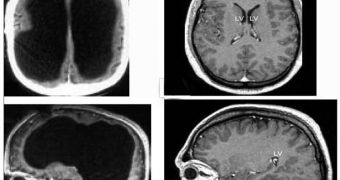Some people really seem to live on four neurons: one for pissing, one for pooping, one for eating and one for sex. But the reality can sometimes leave us speechless.
A French team got really stunt when they found a 44 year-old man with an unusually tiny brain, still able to live an entirely normal life despite this. Scan images of the brain revealed a huge fluid-filled chamber (named ventricle) occupying most of the skull box, leaving little more than a thin layer of real brain tissue. Ventricles are normal tiny chambers filled with cerebrospinal liquid that cushions the brain.
"It is hard for me [to say] exactly the percentage of reduction of the brain, since we did not use software to measure its volume. But visually, it is more than a 50% to 75% reduction," said Lionel Feuillet, a neurologist at the Mediterranean University in Marseille, France.
With all his condition, the man is a married man, father of two children and works as a civil servant. He went to the hospital after he felt mild weakness in his left leg. When the physicians looked in his medical history, they found that during his infancy, the man had had a shunt inserted into his head to drain away hydrocephalus (water on the brain) and the shunt was removed when he was 14 years old.
That's why the team took the decision to verify his brain state with computed tomography (CT) scanning technology and magnetic resonance imaging (MRI). The man scored 75 at IQ tests, below the average score of 100 but not classifying him as mentally retarded or disabled.
"The whole brain was reduced - frontal, parietal, temporal and occipital lobes - on both left and right sides. These regions control motion, sensibility, language, vision, audition, and emotional and cognitive functions," Feuillet told New Scientist. This shows "the brain is very plastic and can adapt to some brain damage occurring in the pre- and postnatal period when treated appropriately," he added.
"What I find amazing to this day is how the brain can deal with something which you think should not be compatible with life. If something happens very slowly over quite some time, maybe over decades, the different parts of the brain take up functions that would normally be done by the part that is pushed to the side," commented Max Muenke, a pediatric brain defect specialist at the National Human Genome Research Institute in Bethesda, Maryland, US, not involved in this investigation.

 14 DAY TRIAL //
14 DAY TRIAL //